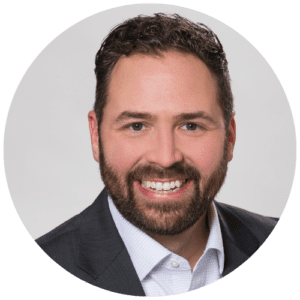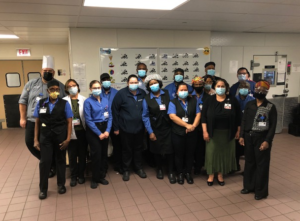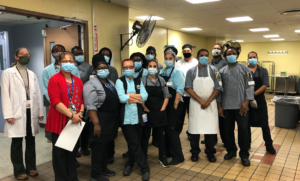Bringing a Sense of Community to Food Service Operations
By Scott Anthony, Regional Director of Operations for Morrison Healthcare

My foodservice career has been a long, winding learning experience, but one that paid dividends during the COVID-19 crisis this spring.
I’ve worked as a chef for 17 years, including four months with the U.S. Air Force in Kuwait following the Sept. 11 attacks on our country. I was part of Operation Enduring Freedom, our country’s response to global terrorism as troops prepared to go into Iraq.
I joined Morrison Healthcare as an executive chef at the Hershey Medical Center in Hershey, Pa. I have a degree in Restaurant Hospitality & Culinary Arts, and after 17 years as a chef, I was looking for a leadership role. I decided to seek a management role as a director seven years ago and haven’t looked back.
During the past seven years, change has been constant. My journey has gone from an executive chef to a regional director of operations, managing 14 hospitals in Pennsylvania, New Jersey, and upstate New York.
Working as a chef, manager, or director at one hospital, it’s natural to develop an organization’s identity. You feel part of the hospital’s team; you see the client every day and have friends in different departments. There is truly an emotional connection with the hospital.
But that changes – for the best – as a regional director. Now, I have working relationships with many people throughout Morrison and Compass. It’s a whole new world that provides connections to people with new information and ideas that help serve patients and hospitals better.
 My increased knowledge about our company has provided me with a new level of information to our operations team. I’m working hard to educate my directors about the vast amount of resources at their disposal. Our teams must understand that the best company in the world supports them.
My increased knowledge about our company has provided me with a new level of information to our operations team. I’m working hard to educate my directors about the vast amount of resources at their disposal. Our teams must understand that the best company in the world supports them.
How This Knowledge Helped During the COVID-19 Crisis
I probably reached out to Human Resources 100 times during those first few weeks of the crisis to find answers to a wide range of issues. In almost every case, I connected one of my directors or managers to someone in our organization to get help or additional resources to solve a problem.
Here’s a great example: when COVID-19 began shutting down cities in the Northeast in March, some of our associates desperately trying to get to work couldn’t make it when the Philadelphia mass transit system closed for several days.
After receiving a call one morning that approximately 15 associates didn’t make it to work, I picked up the phone to speak with our Human Resources department team looking for answers. We quickly agreed that we needed to show our associates that we could help them do their jobs in times of crisis.
After several calls and discussions about potential solutions, our directors proposed reaching out to Uber to arrange for a corporate discount. This arrangement enabled approximately 30 associates to commute to work for three months. It made a difference in their lives and in our ability to serve patients.
 At the same time, my teams worked with officials at several hospitals about closing the self-service food stations and other sections of our cafés. Again, we needed guidance from the Morrison regulatory team specializing in government regulations to help us make decisions. In some of these cases, I helped connect the team with the appropriate people in Morrison.
At the same time, my teams worked with officials at several hospitals about closing the self-service food stations and other sections of our cafés. Again, we needed guidance from the Morrison regulatory team specializing in government regulations to help us make decisions. In some of these cases, I helped connect the team with the appropriate people in Morrison.
Serving Our Clients
I wasn’t allowed to meet with most hospital administrators during the height of the pandemic’s first couple of months. So, I led our teams remotely by being available at any hour of the day and night.
Each hospital had different evolving problems by the minute, and I had to consult with my teams at a moment’s notice if needed.
Hospitals had questions about many aspects of our food service. For example, I received calls about Morrison’s position on fountain machines – were we planning to operate or shut them down? I called our regulatory teams to determine the safest decision and find out how other hospitals were operating. In turn, I connected these experts with my directors.
Other hospitals wanted to move to all disposable plates, glasses, and eating utensils for patients, believing it was the safest way to go. But some hospitals choosing all paper ran out of supplies in a short period, so we needed to find more supplies.
As hospitals have re-opened, we’ve led the charge in providing infection control measures to increase safety. Self-service has been taboo at most facilities, and there are plenty of plexiglass shields to reduce any contact. All food is wrapped in aluminum foil or containers, and we’ll continue to limit capacity.
I’ve been most proud of how nimble my teams became in adapting to each day and each new situation through it all. We just kept saying to each other, “what’s next?” and forged ahead. Our operational teams are truly service heroes. They took care of everyone’s needs, no matter how big or small the request.




